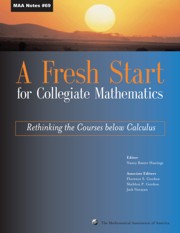Book contents
- Frontmatter
- Preface
- Contents
- Introduction
- Background
- Theme 1 New Visions for Introductory Collegiate Mathematics
- Theme 2 The Transition from High School to College
- Theme 3 The Needs of Other Disciplines
- Theme 4 Student Learning and Research
- Theme 5 Implementation
- Theme 6 Influencing the Mathematics Community
- Ideas and Projects that Work: Part 1
- Ideas and Projects that Work: Part 2
- 35 Mathematics in Action: Empowering Students with Introductory and Intermediate College Mathematics
- 36 Precalculus: Concepts in Context
- 37 Rethinking College Algebra
- 38 From The Bottom Up
- 39 The Functioning in the Real World Project
- 40 The Importance of a Story Line: Functions as Models of Change
- 41 Using a Guided-Inquiry Approach to Enhance Student Learning in Precalculus
- 42 Maricopa Mathematics
- 43 College Algebra/Quantitative Reasoning at the University of Massachusetts, Boston
- 44 Developmental Algebra: The First Mathematics Course for Many College Students
- 45 Workshop Precalculus: Functions, Data, and Models
- 46 Contemporary College Algebra
- 47 Precalculus: A Study of Functions and Their Applications,
- 48 Success and Failures of a Precalculus Reform Project
46 - Contemporary College Algebra
from Ideas and Projects that Work: Part 2
- Frontmatter
- Preface
- Contents
- Introduction
- Background
- Theme 1 New Visions for Introductory Collegiate Mathematics
- Theme 2 The Transition from High School to College
- Theme 3 The Needs of Other Disciplines
- Theme 4 Student Learning and Research
- Theme 5 Implementation
- Theme 6 Influencing the Mathematics Community
- Ideas and Projects that Work: Part 1
- Ideas and Projects that Work: Part 2
- 35 Mathematics in Action: Empowering Students with Introductory and Intermediate College Mathematics
- 36 Precalculus: Concepts in Context
- 37 Rethinking College Algebra
- 38 From The Bottom Up
- 39 The Functioning in the Real World Project
- 40 The Importance of a Story Line: Functions as Models of Change
- 41 Using a Guided-Inquiry Approach to Enhance Student Learning in Precalculus
- 42 Maricopa Mathematics
- 43 College Algebra/Quantitative Reasoning at the University of Massachusetts, Boston
- 44 Developmental Algebra: The First Mathematics Course for Many College Students
- 45 Workshop Precalculus: Functions, Data, and Models
- 46 Contemporary College Algebra
- 47 Precalculus: A Study of Functions and Their Applications,
- 48 Success and Failures of a Precalculus Reform Project
Summary
Contemporary College Algebra is designed to educate students for the future rather than to train them for the past. The course, developed in collaboration with faculty in several disciplines as well as with people in the workplace, provides a strong base for quantitative literacy programs.
The primary goal of the course is to empower students to become exploratory learners, not to master a list of algebraic rules. Some of the means that are used to establish an exploratory environment for the students include:
Queries for engaging students in questioning and exploring the material being presented
Exercises that explicitly ask students to explore, ask what-if type questions, make up examples, further investigate worked examples, or iterate for the purpose of recognizing a pattern and developing a sense for the behavior of the solution
Graphically fitting a curve to a data set
Small group work with both in-class activities and out-of-class group projects. In-class activities culminate in student presentations to the class and out-of-class projects culminate in written reports.
Other goals of the course include:
Improve communications skills: Students read about, write about, listen to, and present mathematical ideas.
Use technology: Every student has daily access to a graphing calculator and/or computer.
Model situations: Students are empowered to use mathematics to quantify real-life situations.
Build confidence: Students develop personal confidence as problem solvers. Specifically they develop confidence in the iterative process: try something, note the errors, modify previous attempt to lessen the errors, and try again.
[…]
- Type
- Chapter
- Information
- A Fresh Start for Collegiate MathematicsRethinking the Courses below Calculus, pp. 380 - 385Publisher: Mathematical Association of AmericaPrint publication year: 2006
- 1
- Cited by

